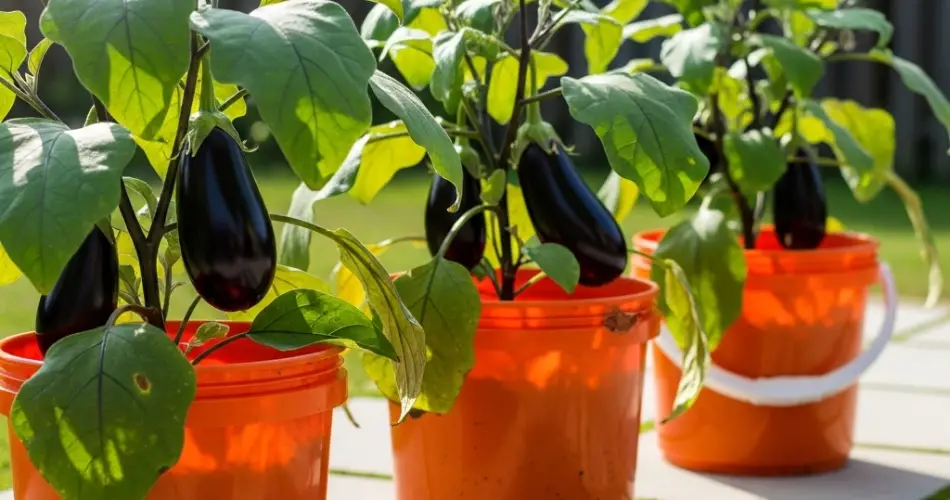Growing eggplants at home is both rewarding and practical, and using buckets as containers offers a simple, space-saving solution. Whether you have a small patio, balcony, or backyard, eggplants can thrive in buckets with the right care. This step-by-step guide walks you through everything you need to know to grow healthy, productive eggplants in container settings.
Why Plant Eggplants in Buckets?
Container gardening offers several advantages for eggplants:
-
Space efficiency – Buckets allow you to grow vegetables even in limited areas like balconies or patios.
-
Mobility – Containers can be moved to optimize sunlight exposure or protect plants from adverse weather.
-
Control over soil – You can choose the perfect soil mix for eggplants, avoiding poor garden soil issues.
-
Pest management – Buckets make it easier to monitor and manage pests compared to in-ground planting.
Using buckets allows even beginners to experience a productive harvest with minimal effort.
Step 1: Choose the Right Bucket
Selecting an appropriate container is essential for successful eggplant growth:
-
Size – Buckets should hold at least 5 gallons (around 19 liters) of soil. Larger buckets support more extensive root systems, promoting stronger plants and better fruit production.
-
Drainage – Drill several holes in the bottom to allow excess water to escape, preventing root rot.
-
Material – Plastic, metal, or sturdy recycled buckets work well. Ensure the bucket is durable and can withstand outdoor conditions.
Step 2: Prepare the Soil
Eggplants thrive in well-draining, nutrient-rich soil:
-
Soil mix – Combine equal parts of garden soil, compost, and perlite or sand. This mixture provides both fertility and drainage.
-
pH balance – Eggplants prefer slightly acidic to neutral soil, around pH 6.0–7.0.
-
Fertilization – Before planting, mix in a slow-release balanced fertilizer to provide essential nutrients for early growth.
Proper soil preparation ensures your eggplants develop healthy roots and strong stems.
Step 3: Planting the Eggplants
Eggplants can be started from seeds or seedlings:
-
Seedlings – Transplant 6–8 week-old seedlings into the bucket. Dig a hole deep enough to cover the root ball without crowding.
-
Spacing – If planting more than one eggplant per bucket, maintain at least 12–18 inches between plants to allow for airflow and prevent overcrowding.
-
Planting depth – Cover the roots completely but avoid burying the stem too deeply.
Firm the soil gently around the base of the plant to provide stability.
Step 4: Watering
Eggplants need consistent moisture for optimal growth:
-
Initial watering – Water thoroughly after planting to settle the soil around the roots.
-
Regular routine – Keep the soil evenly moist but not soggy. Water when the top inch of soil feels dry.
-
Avoid wet leaves – Watering at the soil level prevents leaf diseases and fungal issues.
Proper watering helps prevent stress and encourages fruit formation.
Step 5: Sunlight and Placement
Eggplants require full sun to thrive:
-
Light requirements – Place the bucket where the plants receive at least 6–8 hours of direct sunlight per day.
-
Rotation – Turn the bucket occasionally to ensure even light exposure, promoting uniform growth and preventing plants from leaning.
Sunlight is critical for healthy leaves, strong stems, and abundant flowers.
Step 6: Supporting the Plants
As eggplants grow, they may need support to prevent bending or breakage under the weight of fruits:
-
Stakes or cages – Insert a stake or small cage into the soil near each plant. Tie the stems loosely with soft ties.
-
Pruning – Remove lower leaves or weak shoots to improve airflow and reduce disease risk.
Support structures help plants focus energy on producing large, healthy fruits.
Step 7: Fertilization and Maintenance
Maintaining soil fertility throughout the growing season is key:
-
Liquid fertilizer – Apply a balanced liquid fertilizer every 2–3 weeks once plants begin flowering.
-
Mulching – Adding a thin layer of organic mulch on top of the soil conserves moisture and suppresses weeds.
-
Pest monitoring – Check leaves regularly for aphids, flea beetles, or caterpillars. Remove pests by hand or use safe insecticidal sprays.
Regular care encourages continuous flowering and fruit production.
Step 8: Harvesting
Eggplants are ready to harvest when their skin is glossy and firm, but before it becomes dull or overly soft:
-
Timing – Depending on the variety, fruits typically mature 70–85 days after transplanting.
-
Technique – Use a sharp knife or scissors to cut the fruit from the stem, leaving a small portion of stem attached. Avoid twisting, as this can damage the plant.
Frequent harvesting encourages the plant to produce more fruits throughout the season.
Final Thoughts
Growing eggplants in buckets is a rewarding and space-efficient method for home gardeners. By choosing the right container, preparing nutrient-rich soil, providing consistent watering, and ensuring sufficient sunlight, you can enjoy a bountiful harvest even in small spaces. With attention to support, fertilization, and pest management, your eggplants will thrive, producing healthy fruits and vibrant foliage throughout the growing season.
Container gardening with eggplants turns even limited spaces into productive gardens, combining practicality with the joy of homegrown produce.



